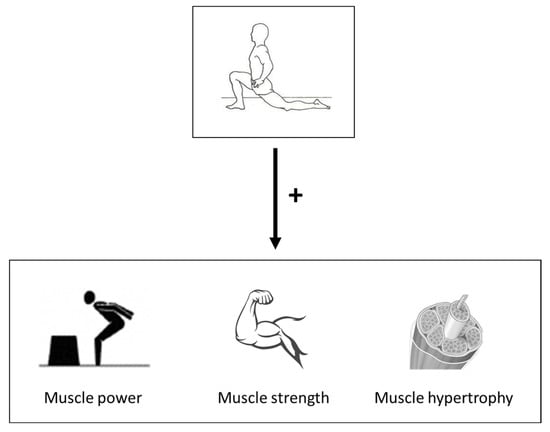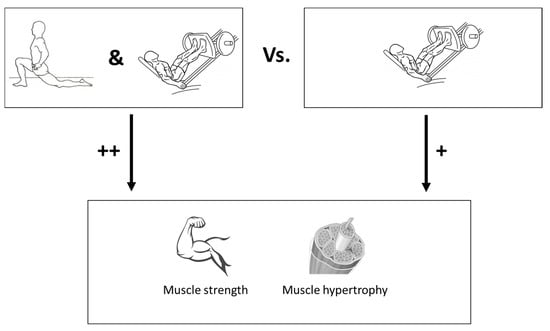The utility of flexibility as a standard component of physical fitness has recently been questioned, sparking a heated debate among scientists. Rsearchers conducted a narrative review of the existing knowledge and concluded that flexibility deserves to be further considered as a standard component of physical fitness. This is based on the findings that in addition to flexibility, long-term static stretching training induces positive effects on muscle strength, muscle power, and muscle hypertrophy, irrespective of age and sex. There are also indications that long-term static stretching training could mitigate the risk of injury. Furthermore, promising evidence shows that combining resistance training with static stretching exercises constitutes an effective approach benefiting muscle strength and hypertrophy more than resistance training alone. Overall, researchers would not support the recent suggestion that flexibility should be retired as a standard component of physical fitness and researchers would advocate for a continuous emphasis on the prescription of stretching exercises.
- range of motion
- health
- muscle strength
- muscle power
1. Chronic Effect of Static Stretching Exercises on Flexibility
2. The Chronic Effects of Static Stretching Exercises on Muscle Strength and Power

3. The Chronic Effect of Static Stretching Exercises on Muscle Hypertrophy

4. Chronic Effect of Static Stretching Exercises on Injury Prevention
This entry is adapted from the peer-reviewed paper 10.3390/youth3010010
References
- Freitas, S.R.; Mendes, B.; Le Sant, G.; Andrade, R.J.; Nordez, A.; Milanovic, Z. Can chronic stretching change the muscle-tendon mechanical properties? A review. Scand. J. Med. Sci. Sport. 2018, 28, 794–806.
- Weppler, C.H.; Magnusson, S.P. Increasing muscle extensibility: A matter of increasing length or modifying sensation? Phys. Ther. 2010, 90, 438–449.
- Brusco, C.M.; Blazevich, A.J.; Pinto, R.S. The effects of 6 weeks of constant-angle muscle stretching training on flexibility and muscle function in men with limited hamstrings’ flexibility. Eur. J. Appl. Physiol. 2019, 119, 1691–1700.
- Magnusson, S.P.; Simonsen, E.B.; Aagaard, P.; Sørensen, H.; Kjaer, M. A mechanism for altered flexibility in human skeletal muscle. J. Physiol. 1996, 497 (Pt 1), 291–298.
- Konrad, A.; Tilp, M. Increased range of motion after static stretching is not due to changes in muscle and tendon structures. Clin. Biomech. 2014, 29, 636–642.
- Zöllner, A.M.; Abilez, O.J.; Böl, M.; Kuhl, E. Stretching skeletal muscle: Chronic muscle lengthening through sarcomerogenesis. PLoS ONE 2012, 7, e45661.
- Blazevich, A.J.; Cannavan, D.; Waugh, C.M.; Fath, F.; Miller, S.C.; Kay, A.D. Neuromuscular factors influencing the maximum stretch limit of the human plantar flexors. J. Appl. Physiol. 2012, 113, 1446–1455.
- Blazevich, A.J.; Cannavan, D.; Waugh, C.M.; Miller, S.C.; Thorlund, J.B.; Aagaard, P.; Kay, A.D. Range of motion, neuromechanical, and architectural adaptations to plantar flexor stretch training in humans. J. Appl. Physiol. 2014, 117, 452–462.
- Hunter, J.P.; Marshall, R.N. Effects of power and flexibility training on vertical jump technique. Med. Sci. Sport. Exerc. 2002, 34, 478–486.
- Nunes, J.P.; Schoenfeld, B.J.; Nakamura, M.; Ribeiro, A.S.; Cunha, P.M.; Cyrino, E.S. Does stretch training induce muscle hypertrophy in humans? A review of the literature. Clin. Physiol. Funct. Imaging 2020, 40, 148–156.
- Warneke, K.; Konrad, A.; Keiner, M.; Zech, A.; Nakamura, M.; Hillebrecht, M.; Behm, D.G. Using Daily Stretching to Counteract Performance Decreases as a Result of Reduced Physical Activity-A Controlled Trial. Int J Env. Res Public Health 2022, 19, 15571.
- Warneke, K.; Brinkmann, A.; Hillebrecht, M.; Schiemann, S. Influence of Long-Lasting Static Stretching on Maximal Strength, Muscle Thickness and Flexibility. Front. Physiol. 2022, 13, 878955.
- Arntz, F.; Markov, M.; Behm, D.G.; Behrens, M.; Negra, Y.; Nakamura, M.; Moran, J. Chaabene. Chronic effects of static stretching exercises on muscle strength and power in healthy individuals across the lifespan: A systematic review with multilevel meta-analysis. Sport. Med. 2023; in press.
- Higgins, J.P.; Thompson, S.G.; Spiegelhalter, D.J. A re-evaluation of random-effects meta-analysis. J. R. Stat. Soc. Ser. A (Stat. Soc.) 2009, 172, 137–159.
- Viechtbauer, W. Confidence intervals for the amount of heterogeneity in meta-analysis. Stat. Med. 2007, 26, 37–52.
- Wang, C.C.; Lee, W.C. A simple method to estimate prediction intervals and predictive distributions: Summarizing meta-analyses beyond means and confidence intervals. Res. Synth. Methods 2019, 10, 255–266.
- Thomas, E.; Ficarra, S.; Nunes, J.P.; Paoli, A.; Bellafiore, M.; Palma, A.; Bianco, A. Does Stretching Training Influence Muscular Strength? A Systematic Review With Meta-Analysis and Meta-Regression. J. Strength Cond. Res. 2022.
- Fukunaga, T.; Roy, R.; Shellock, F.; Hodgson, J.; Edgerton, V. Specific tension of human plantar flexors and dorsiflexors. J. Appl. Physiol. 1996, 80, 158–165.
- Simpson, C.L.; Kim, B.D.H.; Bourcet, M.R.; Jones, G.R.; Jakobi, J.M. Stretch training induces unequal adaptation in muscle fascicles and thickness in medial and lateral gastrocnemii. Scand. J. Med. Sci. Sport. 2017, 27, 1597–1604.
- Ferrari, R. Writing narrative style literature reviews. Med. Writ. 2015, 24, 230–235.
- Blazevich, A.J. Effects of physical training and detraining, immobilisation, growth and aging on human fascicle geometry. Sport. Med. 2006, 36, 1003–1017.
- Brosseau, L.; Wells, G.A.; Pugh, A.G.; Smith, C.A.; Rahman, P.; Àlvarez Gallardo, I.C.; Toupin-April, K.; Loew, L.; De Angelis, G.; Cavallo, S. Ottawa Panel evidence-based clinical practice guidelines for therapeutic exercise in the management of hip osteoarthritis. Clin. Rehabil. 2016, 30, 935–946.
- Wilson, G.J.; Elliott, B.C.; Wood, G.A. Stretch shorten cycle performance enhancement through flexibility training. Med. Sci. Sport. Exerc. 1992, 24, 116–123.
- Shrier, I. Does stretching improve performance?: A systematic and critical review of the literature. Clin. J. Sport Med. 2004, 14, 267–273.
- Godges, J.; Macrae, H.; Longdon, C.; Tinberg, C. The effects of two stretching procedures on the economy of walking and jogging. J. Orthop. Sport. Phys. Ther. 1989, 7, 350–357.
- Worrell, T.W.; Smith, T.L.; Winegardner, J. Effect of hamstring stretching on hamstring muscle performance. J. Orthop. Sport. Phys. Ther. 1994, 20, 154–159.
- Halbertsma, J.P.; Göeken, L.N. Stretching exercises: Effect on passive extensibility and stiffness in short hamstrings of healthy subjects. Arch. Phys. Med. Rehabil. 1994, 75, 976–981.
- Giovannucci, E.L.; Rezende, L.F.M.; Lee, D.H. Muscle-strengthening activities and risk of cardiovascular disease, type 2 diabetes, cancer and mortality: A review of prospective cohort studies. J. Intern. Med. 2021, 290, 789–805.
- Nascimento, W.; Ferrari, G.; Martins, C.B.; Rey-Lopez, J.P.; Izquierdo, M.; Lee, D.H.; Giovannucci, E.L.; Rezende, L.F.M. Muscle-strengthening activities and cancer incidence and mortality: A systematic review and meta-analysis of observational studies. Int. J. Behav. Nutr. Phys. Act. 2021, 18, 69.
- Bull, F.C.; Al-Ansari, S.S.; Biddle, S.; Borodulin, K.; Buman, M.P.; Cardon, G.; Carty, C.; Chaput, J.-P.; Chastin, S.; Chou, R. World Health Organization 2020 guidelines on physical activity and sedentary behaviour. Br. J. Sport. Med. 2020, 54, 1451–1462.
- da Rosa Orssatto, L.B.; Cadore, E.L.; Andersen, L.L.; Diefenthaeler, F. Why fast velocity resistance training should be prioritized for elderly people. Strength Cond. J. 2019, 41, 105–114.
- Warneke, K.; Zech, A.; Wagner, C.-M.; Konrad, A.; Nakamura, M.; Keiner, M.; Schoenfeld, B.J.; Behm, D.G. Sex differences in stretch-induced hypertrophy, maximal strength and flexibility gains. Front. Physiol. 2023, 13, 1078301.
- Yahata, K.; Konrad, A.; Sato, S.; Kiyono, R.; Yoshida, R.; Fukaya, T.; Nunes, J.P.; Nakamura, M. Effects of a high-volume static stretching programme on plantar-flexor muscle strength and architecture. Eur. J. Appl. Physiol. 2021, 121, 1159–1166.
- Panidi, I.; Bogdanis, G.C.; Terzis, G.; Donti, A.; Konrad, A.; Gaspari, V.; Donti, O. Muscle architectural and functional adaptations following 12-weeks of stretching in adolescent female athletes. Front. Physiol. 2021, 12, 701338.
- Van Every, D.W.; Coleman, M.; Rosa, A.; Zambrano, H.; Plotkin, D.; Torres, X.; Mercado, M.; De Souza, E.O.; Alto, A.; Oberlin, D.J. Loaded inter-set stretch may selectively enhance muscular adaptations of the plantar flexors. PLoS ONE 2022, 17, e0273451.
- Schoenfeld, B.J.; Wackerhage, H.; De Souza, E. Inter-set stretch: A potential time-efficient strategy for enhancing skeletal muscle adaptations. Front Sport. Act Living 2022, 4, 1035190.
- Evangelista, A.L.; De Souza, E.O.; Moreira, D.C.B.; Alonso, A.C.; Teixeira, C.V.S.; Wadhi, T.; Rauch, J.; Bocalini, D.S.; Pereira, P.E.A.; Greve, J.M.D. Interset Stretching vs. Traditional Strength Training: Effects on Muscle Strength and Size in Untrained Individuals. J. Strength Cond. Res. 2019, 33 (Suppl. S1), S159–S166.
- Woods, K.; Bishop, P.; Jones, E. Warm-up and stretching in the prevention of muscular injury. Sport. Med. 2007, 37, 1089–1099.
- McHugh, M.P.; Cosgrave, C.H. To stretch or not to stretch: The role of stretching in injury prevention and performance. Scand. J. Med. Sci. Sport. 2010, 20, 169–181.
- Stojanovic, M.D.; Ostojic, S.M. Stretching and injury prevention in football: Current perspectives. Res. Sport. Med. 2011, 19, 73–91.
- Behm, D.G.; Kay, A.D.; Trajano, G.S.; Alizadeh, S.; Blazevich, A.J. Effects of stretching on injury risk reduction and balance. J. Clin. Exerc. Physiol. 2021, 10, 106–116.
- Cross, K.M.; Worrell, T.W. Effects of a static stretching program on the incidence of lower extremity musculotendinous strains. J Athl Train 1999, 34, 11–14.
- Sadler, S.G.; Spink, M.J.; Ho, A.; De Jonge, X.J.; Chuter, V.H. Restriction in lateral bending range of motion, lumbar lordosis, and hamstring flexibility predicts the development of low back pain: A systematic review of prospective cohort studies. BMC Musculoskelet. Disord. 2017, 18, 179.
- Kemmochi, M.; Sasaki, S.; Ichimura, S. Association between reduced trunk flexibility in children and lumbar stress fractures. J. Orthop. 2018, 15, 122–127.
- Witvrouw, E.; Mahieu, N.; Danneels, L.; McNair, P. Stretching and injury prevention: An obscure relationship. Sport. Med. 2004, 34, 443–449.
